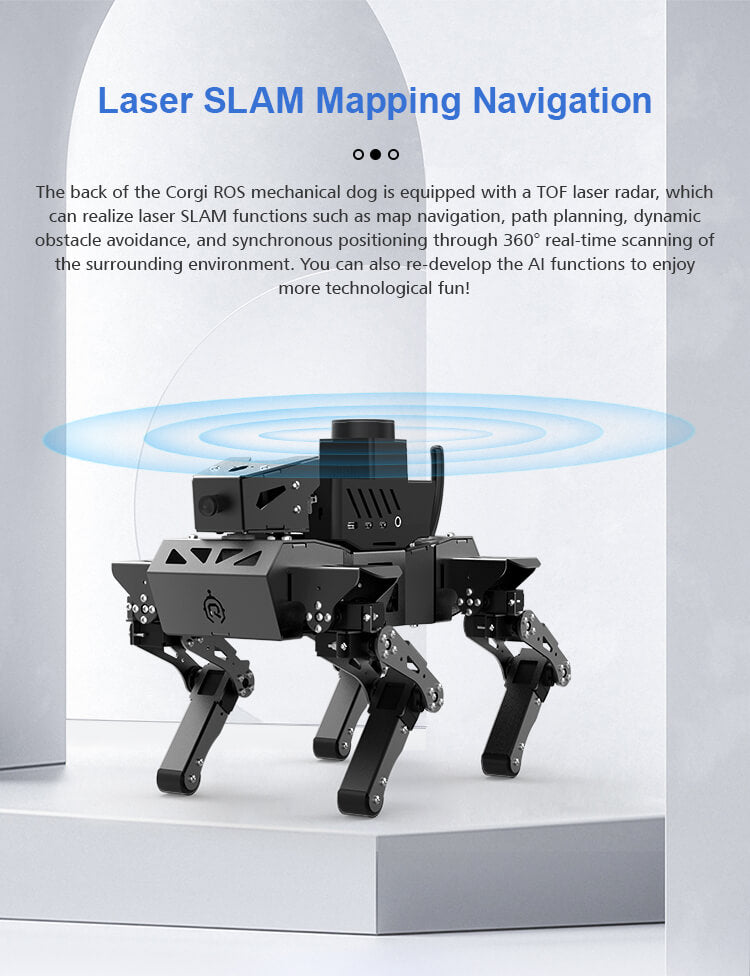Today, with the rapid development of robotics technology, various intelligent robots have sprung up. The Corgi robot dog has attracted widespread attention for its unique design and cute appearance. ROS (Robot Operating System), as an open source robot software framework, provides strong support for robot research and development. When the Corgi robot dog and ROS meet, what kind of sparks will the two create, and what kind of future will lead robotics technology to?
1. Corgi Robot Dog: The Rising Star of Robotics
The Corgi robot dog has become a star product in the current field of robotics due to its corgi-like appearance and flexible mobility (13 servos on the body). It can not only perform basic mobility and navigation tasks, but also achieve advanced functions such as environmental perception and autonomous obstacle avoidance through the sensors and algorithms it carries. The uniqueness of the Corgi robot dog lies in its high degree of customizability and scalability. Users can add various functional modules to it according to their own needs to achieve more diverse application scenarios.
2. ROS: the cornerstone of robotics technology
As an open source robot software framework, ROS has been favored by the majority of robot developers since its inception. It provides a rich set of software libraries and tools and supports multiple programming languages, making the writing and debugging of robot software more efficient and convenient. ROS also adopts a distributed architecture, which can support the collaborative work of multiple robot systems, providing strong support for the development of robotics technology.
3. Collision and fusion of Corgi robot dog and ROS
When the Corgi robot dog meets ROS, the collision and fusion between the two become possible. First of all, ROS provides powerful software support for the Corgi robot dog. Through ROS, the Corgi robot dog can more easily implement various complex functions, such as indoor mapping, environment perception, path planning, autonomous navigation, etc. At the same time, the distributed architecture of ROS also enables the Corgi robot dog to better collaborate with other robots or sensors to achieve more intelligent applications.
Secondly, the customizability and scalability of the Corgi robot dog provide a broader space for ROS applications. Users can add various ROS software packages to the Corgi robot dog according to their own needs to achieve more diverse functions. For example, ROS can be used to add speech recognition function to the Corgi robot dog, so that it can interact with humans more naturally; or ROS can be used to add visual processing functions to the Corgi robot dog, so that it can recognize and track targets, etc.
Finally, the integration of Corgi robot dog and ROS also promotes the innovation and development of robotics technology. Through continuous exploration and practice, we can discover more application scenarios and possibilities and promote the widespread application of robotic technology in various fields. At the same time, the integration of Corgi robot dog and ROS also provides new ideas and methods for robotics education, allowing more people to participate in the research, development and application of robotics technology.
4. Conclusion
When the Corgi robot dog meets ROS, the collision and fusion between the two show us the infinite possibilities of robotics technology. In the future, with the continuous advancement of technology and the continuous expansion of application scenarios, we have reason to believe that robotics technology will bring more convenience and surprises to mankind. At the same time, we also look forward to more innovators and practitioners joining in the research, development and application of robotics technology to jointly promote the development and progress of robotics technology.
When Corgi Robot Dog Meets ROS: The Collision and Fusion of Intelligent Robotics

